This is not a recent build, but I have been meaning to post it for several years. It is also a precursor to a 3-way speaker build thread I intend to post that builds on this one.
Design Requirements
I was replacing an old NHT1259-based sub that had been in the corner and had sufficient output for the room, but I wanted lower distortion, more headroom and it had to be hidden. I was also planning on replacing closed cabinets with an open stereo rack that would be perpendicular to the wall, and obscured from view by a screen. This would allow me to easily access the front and back of each component, and had no doors that would trap heat. I could have built subs into the front corner wall, but this would have been an involved project entering attic space below a sloping roofline, and I decided it would be easier to push the stereo rack to the ceiling and leave room underneath it for the sub (centered on the front wall). Here is a rendering with the outgoing sub under the new rack:
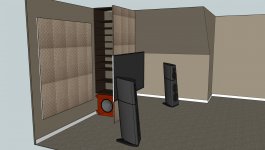
Being directly under the stereo rack (but not touching it), I knew I wanted to limit vibration, so I decided to build a push-push sub. Limiting it to the width of the rack above it did not leave enough depth for back to back drivers, so they would need to be rotated and fire along the length of the room instead of left to right. However, I did not like the idea of them firing into the wall and the back of the screen, so I decided to have them face each other and radiate out a slot.
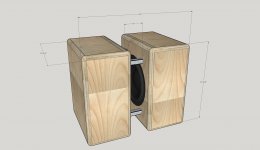
Design Details
The room is an odd L shape to the back left, and with an additional bump out and a sloped ceiling to the right. I did not try to simulate room gain or modes. I did simulate and measure the nearfield response, and I measured the response at the listening position with room gain. Coincidentally, the room gain flattened most of the low end falloff and I did not have to apply any EQ to raise the low end. The sub is crossed over to the main speakers at 80Hz and room modes are equalized out at the listening position below 150Hz.
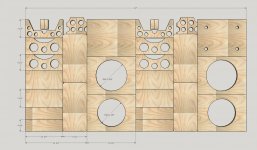
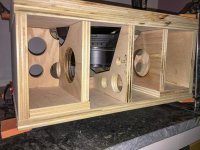
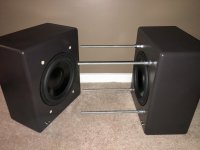
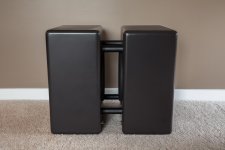
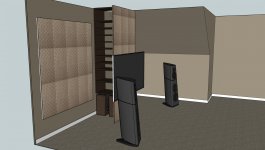
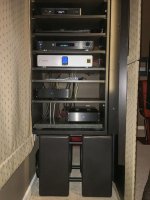
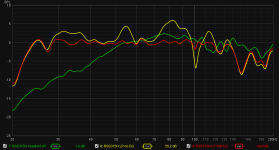
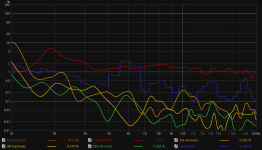
More build photos available here.
Design Requirements
I was replacing an old NHT1259-based sub that had been in the corner and had sufficient output for the room, but I wanted lower distortion, more headroom and it had to be hidden. I was also planning on replacing closed cabinets with an open stereo rack that would be perpendicular to the wall, and obscured from view by a screen. This would allow me to easily access the front and back of each component, and had no doors that would trap heat. I could have built subs into the front corner wall, but this would have been an involved project entering attic space below a sloping roofline, and I decided it would be easier to push the stereo rack to the ceiling and leave room underneath it for the sub (centered on the front wall). Here is a rendering with the outgoing sub under the new rack:

Being directly under the stereo rack (but not touching it), I knew I wanted to limit vibration, so I decided to build a push-push sub. Limiting it to the width of the rack above it did not leave enough depth for back to back drivers, so they would need to be rotated and fire along the length of the room instead of left to right. However, I did not like the idea of them firing into the wall and the back of the screen, so I decided to have them face each other and radiate out a slot.

Design Details
- (2) Dayton Audio RSS315HF-4 12" Reference
- HF Subwoofer 4 Ohm in sealed cabinets.
- Dual drivers face each other for force cancellation, which works quite well. Cabinet vibration is almost imperceptible.
- Both cabinets are cut from a single sheet of plywood, well braced, and doubled up on some walls.
- The cabinets are joined by heavy, threaded rods which are concealed by aluminum tubing. I think the tubing is causing the high frequency ringing during sweep measurements, but it is far outside the passband.
- Rubber gaskets under large diameter washers ensure an airtight seal for the threaded rods.
- Copious use of shellac prior to priming ensures no seams are visible through the paint.
- Spray painted using rattle cans, but finished with General Finishes flat water-based poly via HVLP.
- Total dimensions (including 4” gap between cabinets) is 23” W x 19.25” H x 16.25” D
- Internal cabinet volume is approximately 30 liters with a QTC of 0.83, but as built, it measures like 20 liters with a QTC of 0.96.
- Crossover and room EQ provided by MiniDSP 2x4HD
The room is an odd L shape to the back left, and with an additional bump out and a sloped ceiling to the right. I did not try to simulate room gain or modes. I did simulate and measure the nearfield response, and I measured the response at the listening position with room gain. Coincidentally, the room gain flattened most of the low end falloff and I did not have to apply any EQ to raise the low end. The sub is crossed over to the main speakers at 80Hz and room modes are equalized out at the listening position below 150Hz.








More build photos available here.
Cool!
While it would change the internal volume and require smart solutions to compensate, if you inverted one driver you would reduce that 2nd harmonic distortion by a huge amount.
Cool!
While it would change the internal volume and require smart solutions to compensate, if you inverted one driver you would reduce that 2nd harmonic distortion by a huge amount.
So push-push with one flipped is significant distortion benefit over push-push as he is running it?
Planning the possibility of sub setups very similar to the OP's, but built into a false wall... If we are able to swing the addition to the house (current events are making us question those plans.) Basically imagine his box sunk into a wall and the only open side is the wall opening. It'd be easy to make the manifold wide enough to flip one basket around if that provides any benefit.
So push-push with one flipped is significant distortion benefit over push-push as he is running it?
Planning the possibility of sub setups very similar to the OP's, but built into a false wall... If we are able to swing the addition to the house (current events are making us question those plans.) Basically imagine his box sunk into a wall and the only open side is the wall opening. It'd be easy to make the manifold wide enough to flip one basket around if that provides any benefit.
Yes, by a huge amount. It compensates that the forward and backward strokes are not exactly symmetric, but with one inverted then the sum of one forward + one back becomes symmetric thus less distortion.
Linkwitz uses it in hits LX521 and previous iterations he called the Dipole Woofer. There is a thread here talking about it also, A Thread for those interested in PPSL enclosures
Make sure you also mount them in a force cancelling setup like MtBiker has in his cool build. I remember a thread a while back when someone tested the distortion of a sub and found that a reduction of box vibration reduced disortion (mainly odd harmonics). And with a force cancelling setup there should be pretty much zero box vibration which is nice.
While it would change the internal volume and require smart solutions to compensate, if you inverted one driver you would reduce that 2nd harmonic distortion by a huge amount.
So push-push with one flipped is significant distortion benefit over push-push as he is running it?
While it is true that 2nd is reduced, 3rd is increased, and it is generally considered that a decreasing amount of harmonics with 2nd higher than 3rd is better sounding.
To add to that, when i discussed this with Nick McKinney he said that a wekk designed linear driver such as the Llambda (or the Acoustic Elegance that descended from them, and others) will have little or no 2nd harmonic reduction.
Given those 2 points i see no benefit, and perhaps a detriment, to push-pull over push-push.
dave
While it is true that 2nd is reduced, 3rd is increased, and it is generally considered that a decreasing amount of harmonics with 2nd higher than 3rd is better sounding.
To add to that, when i discussed this with Nick McKinney he said that a wekk designed linear driver such as the Llambda (or the Acoustic Elegance that descended from them, and others) will have little or no 2nd harmonic reduction.
Given those 2 points i see no benefit, and perhaps a detriment, to push-pull over push-push.
dave
Yes, the 3rd order reduction was strictly measured due to reduced vibration and not due to inverting one driver.
And on the 2nd order distortion not being significant that is only at ~ 100 and upwards. In the sub bass it makes a massive difference.
His own measurements show an excess of 2nd order distortion and a large peak at 30 hz. We can for the comparison use some measurements of a beast of a sub, the Seas L26ROY. Even it starts to rise in 2nd order distortion at below 100 hz. It is only true if the main distortion component is the actual motor, but for subs it is often the surround and suspension where inverting one driver can cancel those in the same way as assymetric motor distortion.
The 3rd order left in a push pull sub is meaningless.
The huge reduction in 2nd to me is the sound improvement.
And they disappear better.
I believe art welter argued the same 2nd/3rd, built push pull, measured it, and then also started carrying the push pull flag.
Ideally you want the drivers as close as you can.
I wouldn’t trust advice on push pull except by people who actually build them.
Djk found the most improvement were for weaker motor drivers.
Shorting rings don’t do much below 150hz.
I’ll get links later tonight.
The huge reduction in 2nd to me is the sound improvement.
And they disappear better.
I believe art welter argued the same 2nd/3rd, built push pull, measured it, and then also started carrying the push pull flag.
Ideally you want the drivers as close as you can.
I wouldn’t trust advice on push pull except by people who actually build them.
Djk found the most improvement were for weaker motor drivers.
Shorting rings don’t do much below 150hz.
I’ll get links later tonight.
Last edited:
PiSpeakers Forum - Push-pull versus shorting rings - Wayne Parham, June 21, 2006 at 16:18:33
"I had originally asked Eminence to investigate the possibility of putting a shorting ring into a subwoofer to reduce harmonic distortion. This would be used as the motor for high-performance subwoofer designs. JBL has been very successful with this technology and even though the distortion reduction works best above 100Hz, they have been able to reduce distortion at subwoofer frequencies as well. So I had hoped Eminence might be able to build an improved subwoofer too...….. Eminence found that they were unable to get significant distortion reduction below 150Hz from a shorting ring. The reason is pretty simple - The shorting ring works like a transformer winding, and it has to inductively couple enough energy to create a magnetic field large enough to offset the difference in force caused by flux modulation. As frequency goes down, this becomes harder and harder to do and the size of the ring becomes prohibitively large. The volume displaced by the ring makes magnet size smaller so more magnet has to be added to compensate and the requirements become a vicious cycle. So there just isn't enough "meat" to make a good flux stabilized subwoofer."
"The charts above show the harmonic spectrum of a high-power 30Hz sine applied to a pair of identical woofers on a baffle. The chart on the right has the woofers mounted in push-pull. Notice that the second harmonic is 25dB lower than the dual-woofer configuration that doesn't employ push-pull drive."
and the dxd 12012
KEN KREISEL DXD-12012 Dual 12" Push-Pull Subwoofer - HomeTheaterHifi.com
"30 Hz, 101 dB, 0.6% distortion? No problem with the KREISEL. No wonder movie and music studios use this subwoofer."
"The DXD-12012 is at least an order of magnitude better than that one, and in fact, has set a new record here at Secrets for the lowest distortion ever measured on any subwoofer."
"I had originally asked Eminence to investigate the possibility of putting a shorting ring into a subwoofer to reduce harmonic distortion. This would be used as the motor for high-performance subwoofer designs. JBL has been very successful with this technology and even though the distortion reduction works best above 100Hz, they have been able to reduce distortion at subwoofer frequencies as well. So I had hoped Eminence might be able to build an improved subwoofer too...….. Eminence found that they were unable to get significant distortion reduction below 150Hz from a shorting ring. The reason is pretty simple - The shorting ring works like a transformer winding, and it has to inductively couple enough energy to create a magnetic field large enough to offset the difference in force caused by flux modulation. As frequency goes down, this becomes harder and harder to do and the size of the ring becomes prohibitively large. The volume displaced by the ring makes magnet size smaller so more magnet has to be added to compensate and the requirements become a vicious cycle. So there just isn't enough "meat" to make a good flux stabilized subwoofer."
"The charts above show the harmonic spectrum of a high-power 30Hz sine applied to a pair of identical woofers on a baffle. The chart on the right has the woofers mounted in push-pull. Notice that the second harmonic is 25dB lower than the dual-woofer configuration that doesn't employ push-pull drive."
and the dxd 12012
KEN KREISEL DXD-12012 Dual 12" Push-Pull Subwoofer - HomeTheaterHifi.com
"30 Hz, 101 dB, 0.6% distortion? No problem with the KREISEL. No wonder movie and music studios use this subwoofer."
"The DXD-12012 is at least an order of magnitude better than that one, and in fact, has set a new record here at Secrets for the lowest distortion ever measured on any subwoofer."
Norman,The 3rd order left in a push pull sub is meaningless.
The huge reduction in 2nd to me is the sound improvement.
And they disappear better.
I believe art welter argued the same 2nd/3rd, built push pull, measured it, and then also started carrying the push pull flag.
I have built a variety of cabinets using push pull and push push, but definitely don't wave flags for either configuration.
About 9 years ago I posted this:
Push Pull vs Normal Distortion Compared
To sum up that post:
"At lower power levels, where the Lab12 is quite clean, no difference could be detected. When pushed at a power level where distortion could be noticed, the most distracting artifact was the audible vent noise from the reversed magnet structure of the PP. The lack of the second harmonic, an octave, made the now predominant third harmonic distortion more apparent in the PP cabinet. This is a music related thing, the third harmonic, being a perfect fifth, may sound OK with some compositions, while sounding “wrong” with others.
Although the technical side of me says reduction of distortion of any sort is a good thing as far as a reproduction system is concerned, both my old ears, and a college freshman apprentice thought the push pull cabinet sounded less “musical” when pushed hard."
As Mark 100s results show, low distortion drivers may even show more distortion with one reversed, and vent noise may predominate.
Art
Sorry art.
It was wayne parham.
Ug, my memory.
Pushed hard, i heard that too on my 4x12's when the ab600a's clip light started flashing a bit.
But my levels weren't past past 120db with 4 drivers.
It was only 150w into 8ohms, 112db.(if it could do 100w).
My only concern is there is a slot resonance.
My 4x12" had a vertical standing wave, maybe at 250hz.
It was wayne parham.
Ug, my memory.
Pushed hard, i heard that too on my 4x12's when the ab600a's clip light started flashing a bit.
But my levels weren't past past 120db with 4 drivers.
It was only 150w into 8ohms, 112db.(if it could do 100w).
My only concern is there is a slot resonance.
My 4x12" had a vertical standing wave, maybe at 250hz.
- Home
- Loudspeakers
- Subwoofers
- Build: Dual mono push-push

